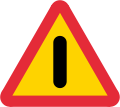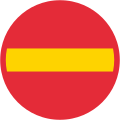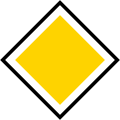| Driving in the Nordic countries Denmark • Finland • Iceland • Norway • Sweden |
| Driving in Europe articles Austria • Denmark • Finland • France • Germany • Iceland • Italy • Norway • Poland • Portugal • Russia • Spain • Sweden • Switzerland • United Kingdom |
In Sweden, driving is the most practical way to get around outside the big cities. While most roads are good, and traffic jams are rare, winter driving and animal collisions are major concerns.
Understand
[edit]In large parts of Sweden it is essential to have a car, mainly due to the long distances, but also because public transport is scarce outside populated areas. Some lines only run on weekdays, with no or few departures on weekends and public holidays. You will encounter people of all ages and experience behind the wheel, which means some of them will drive excessively slow, well below speed limits, lowering their speed well in advance of a turn, and perhaps even driving insecurely.
Legal requirements
[edit]
All motor vehicles in Sweden must have their headlights on, even at daytime. Modern Swedish-sold cars always have the lights turned on automatically (unless you actively turn it off), so if you rent a car in Sweden you won't have to worry about it. If you drive without lights you may find other drivers flashing their headlights at you to inform you. If your car is fitted with daytime running lights these are sufficient in daytime.
Driver and passengers must use seat belts, when the car is equipped with them (antique cars are exempt). Crash helmets are mandatory for drivers and passengers of motorcycles. Motorcycle passengers under the age of seven may use any appropriate helmet — a riding helmet, skiing helmet or bicycle helmet.
In winter conditions from 1 December to 31 March all cars used in Sweden are required by law to have either studded tires or un-studded winter friction tires (or equivalent measures like snow chains). The tyres must be marked, M+S, M-s, M.S, M&S, MS or Mud and Snow. "Winter conditions" are to be expected in this period. Studded winter tires are allowed 1 October to 15 April. See the Transport Ministry info (in English)
There are streets in Stockholm, Uppsala and Gothenburg where studded tyres are banned. There is a road sign for this.
If parking a German vehicle, and using SMS or a phone app to pay, do not add a hyphen to the vehicle number, even if this is commonly done in Germany. If parking a Belgian, Dutch, Finnish, Hungarian, Irish or Latvian vehicle, do add the hyphens, if possible (apps might not allow them). The police are extremely strict about the precise content of the plate to be used, even if these faults can not point to a different vehicle. The supreme court ruled that doing your best is enough (see article in Swedish), but it might still pay to be careful.
Roads
[edit]
The European road network goes through Sweden, and mostly have higher standard than national or local roads. Some important roads are:
- E4 – from Helsingborg via Jönköping to Stockholm and all the way north to Haparanda at the Finnish border; see E4 through Sweden.
- E6 – from Trelleborg via Malmö to Gothenburg and Oslo, Norway; see E6 through Sweden and Norway.
- E10 – from Luleå to Riksgränsen, onwards to Narvik; see E10 through Sweden and Norway.
- E18 – from border of Norway at Årjäng to Norrtälje, with ferry connections to Finland; see E18
- E20 – from Malmö via E6 to Gothenburg, then to Stockholm, where it ends at the harbour with ferry connections to Finland, Estonia, Latvia and Russia.
- E22 – from Trelleborg via Malmö, Karlskrona to Norrköping, where it ends as an onramp to E4.
- E45 – from Gothenburg through inland Sweden to Karesuando; see E45 through Europe.
Most of the European roads outside Norrland are highways.
Second in the hierarchy are national roads (riksvägar) with two digit numbers.
Roads with more than two digits are called regional roads (länsvägar) and come in two flavors. Major ones are numbered 100–400 and are signposted. Minor ones with higher numbers do not have signposted numbers, although some GPS maps have those numbers.
Finding directions
[edit]- The best markings are made with big blue signs with the name of the upcoming towns.
- If the road leading there is a freeway, the signs are green instead of blue.
- Unless you are going on a very big road, make your directions based on what towns or villages you are passing and keep an eye out for these signs instead of the road numbers.
Speed limits
[edit]
The current speed limits are very well marked by signs with speed limits shown in km/h. Speed signs on each side of the road mean from this point this is the new speed. A sign on the right only indicates the speed limit has not changed.
Passenger cars, motorcycles, light lorries and buses with a total weight of 3.5 metric tons or less have no special speed restrictions other than whatever the speed limit is for the road.
Motor vehicles and motorcycles with a braked trailer have a speed limit of 80 km/h.
Motor vehicles with an unbraked trailer whose total weight (or curb weight when the trailer is not loaded) does neither exceed 750 kg nor half the towing vehicle's curb weight have a speed limit of 80 km/h.
Motor vehicles with an unbraked trailer whose total weight (or curb weight if the wagon is not loaded) exceeds half the towing vehicle's curb weight have a speed limit of 40 km/h.
The speed limit for roads outside built-up areas is always 70 km/h unless otherwise indicated.
Some signs also indicate the speed limit. These are:
- The freeway (motorväg) sign also means 110 km/h unless the accompanying speed sign specifies another limit.
- The highspeed road (motortrafikled) sign indicates 90 km/h (100 km/h on roads with cable fence between the lanes).
- The start of built-up area sign means 50 km/h unless the accompanying speed sign specifies another limit.
- The end of built-up area sign means 70 km/h.
The respect for the speed limit is rather poor. Often, when you are driving at the correct speed on a 70 or 90 km/h road, you will constantly get passed by other cars or be urged to get out of the way to let them pass. On the other hand, speeding on 30 km/h roads is not accepted. If caught, speeding will cost you from 1500 kr, for 1–10 km/h too fast, to 4000 kr, for 36–40 km/h too fast on 70 km/h or faster roads. Speeding on slower roads is more expensive.
Road signs
[edit]Sweden follows the Vienna convention regarding road signs, so they are more or less the same as in the rest of Europe – but different from those e.g. in the U.S.A. The warning signs are triangular and have symbols that should be understandable.
These are some signs that could need explanation for foreign visitors.
-
Other danger (think exclamation mark)
-
No entry
-
No parking
-
No stopping
-
Mandatory direction
-
Priority road
-
Yield (give way)
-
Passing place (on single-track road)
-
European road
-
National road (2 digits)
-
County road (3 digits)
-
Upcoming national road
Some useful phrases that might be found on signs
[edit]| 1 tim | 1 hour |
| Avgift | Fee |
| Gäller (även) ... | Concerns (also) ... |
| Gäller ej ... | Does not concern ... |
| Parkering förbjuden | No Parking |
| P-skiva | Parking disc |
| Utfart | Exit (for vehicles) |
| Utgång | Exit (for pedestrians) |
Drunk driving
[edit]Do not even think about driving after you have drunk alcohol. The legal limit is 0.02 per cent, only a quarter of that in the United States, Canada, or Britain. This limit means that you cannot drink one beer before driving. Police, at any time, can take blood by force, and if you are over the limit, you may lose your driving license and may even get jail time.
Lorries
[edit]Lorries (trucks) with trailers are often longer than in other European countries. Maximum length is 25.25 m (82.8 ft) instead of 18 m (59 ft) in continental Europe. This is the standard and does not have signs indicating a long vehicle. These vehicles are allowed on all roads unless there's a local weight or length restriction. Keep this in mind when trying to overtake. It's not uncommon to meet these lorries fully loaded with timber on narrow, curvy rural roads. If so, slow down, keep out or find a wide place to meet.
Super-long vehicles at 34.5 m (113 ft) are allowed on main highways, and carry an indication sign. Only overtake them when there is plenty of space.
Stay safe
[edit]
Animal collisions
[edit]Many countryside accidents are animal collisions. The biggest roads normally have fences against wild animals, but the smaller roads do not. You need to look out for deer and moose unless you want a 500 kg animal coming through the windscreen. Steer to the rear of the animal, as it might run forward when scared. In the north you will also have to watch out for reindeer. They usually travel in herds. Always slow down until all of them have passed. Reindeer are not that agile and unwilling to jump into a ditch. They will follow the road to the next level place at the roadside and then disappear into the wilderness.
Be extra careful to wild animals on the roads under these circumstances:
- Sunrise/sunset.
- Springtime (as moose reject last year's calves and give birth to new ones).
- Moose hunting season in early October.
- Edge of forests.
- Bridges across streams.
In some cases there are fences along part of the road and then the fences stop for the purpose of letting the animals pass. In such cases and in other places where wild animals are often seen there are normally warning signs.
These animals are mostly moving at dusk and dawn. While driving along lakes be especially observant as animals go for drinks at the lakes. Also, if driving in the hunting season, the wild animals might be scared by hunting parties and move around more than usual. It is normal for an ongoing hunting party to place temporary triangular traffic warning signs at the edge of roads with the text: "Jakt pågår" (ongoing hunt).
In the northern parts of Sweden, the reindeer owners move their reindeers. They mark that they are moving their reindeers with black garbage bags hanging from the “plogkäppar” (markers for the plough drivers to see the road). So if you are in the northern parts of Sweden and see garbage bags on the roadside, drive carefully.
If you hit an animal and it wanders off into the woods wounded, don't forget to mark the spot where it wandered into the forest and call the police. Hitting an animal is not a crime, but not reporting it is. Your car must be fitted with a special paper ribbon (viltolycksremsa) for this purpose. The purpose for this is to be able to use dogs to hunt down the wounded animal – viltolycka.se (in Swedish only).
| “ | According to section 26 of the Hunting Act and section 40 of the Hunting Regulation, a collision between motor vehicles and bear (björn), wolf (varg), wolverine (järv), lynx (lodjur), elk (älg), red deer (kronhjort), fallow deer (dovhjort), roe deer (rådjur), otter (utter), wild boar (vildsvin), mouflon (mufflonfår) and eagle (örn) must be reported to the police even if the animal is not clearly damaged. The site of the collision must also be highlighted. Not to report a collision is punishable and fined. | ” |
| viltolycka.se | ||
A-traktor
[edit]
An a-traktor (also known as epatraktor) is a rebuilt (old) car where the transmission is locked, so the maximum speed is 30 km/h (though many vehicles can illegally unlock higher speeds). An A-traktor can be legally driven from the age of 15. The vehicle has a large red triangular warning sign on the rear end, and must give way to other traffic by driving on the shoulder of the road when necessary. The A-traktor is common in the countryside. They have been involved in some serious incidents, and drivers in Sweden should learn how to interact with them.
Crime
[edit]While Sweden has a low to moderate crime rate, car burglaries are not unheard of. Use common sense, especially in cities, and avoid leaving valuables in the car.
Fuel
[edit]Standard fuel (drivmedel) in Sweden are 95 octane petrol (gasoline; Swedish: bensin), diesel and E85, an ethanol (etanol) fuel blend of 85% ethanol fuel and 15% petrol. Prices for petrol and diesel are high due to taxation, but usually on par with other Western European countries. Diesel is generally more expensive than petrol. 98 octane petrol is also available on some filling stations.
Fuel gas (fordonsgas) is available at 180 stations, and there are more than 2,000 public charging stations (laddstation) for electric cars[dead link] — most of them in the southern parts of Sweden.
Electric cars have become very popular in Sweden, and the charging network is constantly being expanded. The guide chargefinder shows all charging sites.
Discount filling stations like din-X, Ingo, st1, Tanka and Qstar usually have the lowest prices, but most of them are without staff and cashless. Domestic cards and credit cards like VISA and Mastercard are accepted. Premium filling stations like Circle K, Gulf, OKQ8, Preem and Shell mostly have a convenience store, a car wash and perhaps cars and trailers for rent. Those along the E4, E6, E20 and E18 European routes might also have rooms or cottages for rent. Premium filling stations that are open 24 hours daily have a sign with the text "Nattöppet" (open at night), but at night they may only have a window hatch open for business (to avoid robberies).
Parking
[edit]Large cities have parking fees basically everywhere, except for suburban shopping centres. Parking fees are in general paid with card in a machine on location, or through a phone app. Coins are being phased out. Many small cities and some shopping areas have no fee, but have a time limit and require a parking disc which show the arrival time. If you don't have a disc you can write a note saying the arrival time.
Tolls
[edit]A few bridges have tolls in Sweden, 4-10 kronor. Payment is always done afterwards monthly, based on an invoice sent to the owner, also for cars from other countries. For rental cars, the rental company will claim the toll plus a fee on the credit card.
A different case is the Oresund bridge, which has around 500 kr toll (large discounts for frequent users), where payment is done on location. International ferries have also a fairly large fee, often paid when booking. Booking in advance is recommended at popular travel seasons. Short domestic ferries are usually free of charge, although some have a fee. Ferries to Gotland cost like international ferries.












